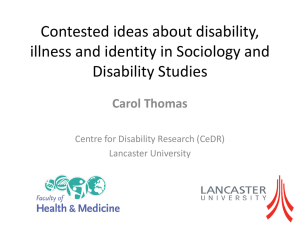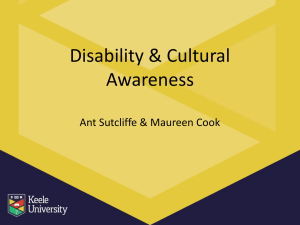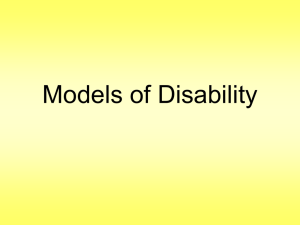Read more about Disability Responsiveness Training [Word
advertisement
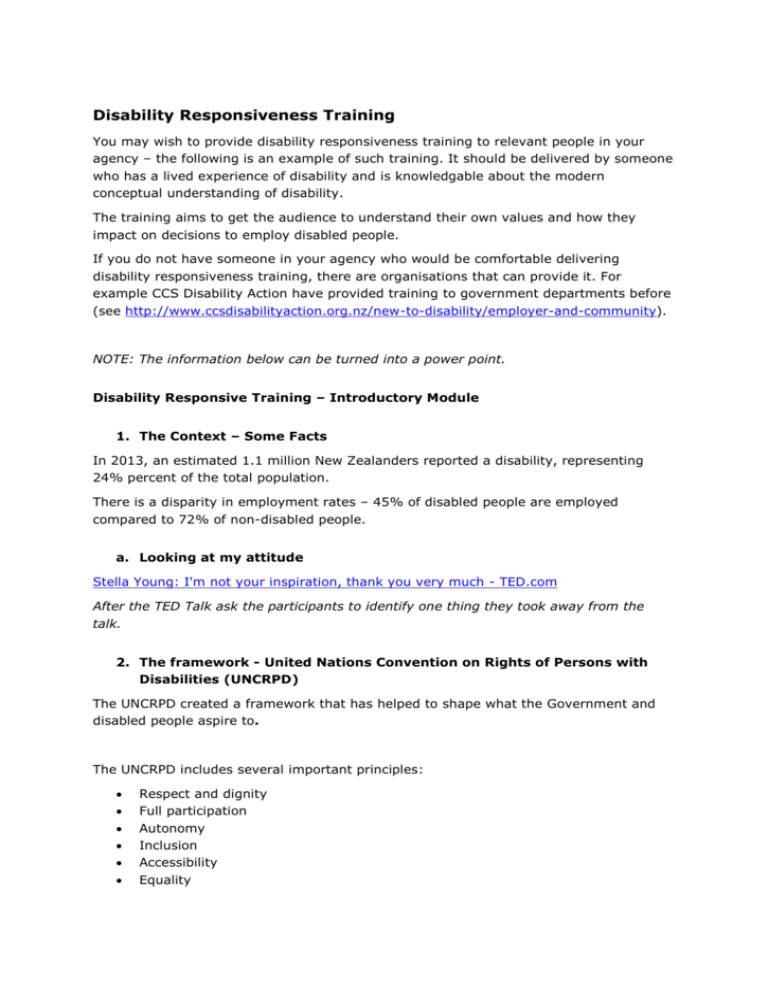
Disability Responsiveness Training You may wish to provide disability responsiveness training to relevant people in your agency – the following is an example of such training. It should be delivered by someone who has a lived experience of disability and is knowledgable about the modern conceptual understanding of disability. The training aims to get the audience to understand their own values and how they impact on decisions to employ disabled people. If you do not have someone in your agency who would be comfortable delivering disability responsiveness training, there are organisations that can provide it. For example CCS Disability Action have provided training to government departments before (see http://www.ccsdisabilityaction.org.nz/new-to-disability/employer-and-community). NOTE: The information below can be turned into a power point. Disability Responsive Training – Introductory Module 1. The Context – Some Facts In 2013, an estimated 1.1 million New Zealanders reported a disability, representing 24% percent of the total population. There is a disparity in employment rates – 45% of disabled people are employed compared to 72% of non-disabled people. a. Looking at my attitude Stella Young: I'm not your inspiration, thank you very much - TED.com After the TED Talk ask the participants to identify one thing they took away from the talk. 2. The framework - United Nations Convention on Rights of Persons with Disabilities (UNCRPD) The UNCRPD created a framework that has helped to shape what the Government and disabled people aspire to. The UNCRPD includes several important principles: Respect and dignity Full participation Autonomy Inclusion Accessibility Equality It also includes a definition of disability: “Disability is an evolving concept, and that disability results from the interaction between persons with impairments and attitudinal and environmental barriers that hinders full and effective participation in society on an equal basis with others” Most importantly the UNCRPD has shifted the way disabled people are viewed. Instead of being seen as “objects” of charity, medical treatment and social protection, disabled people are seen as “subjects” with rights and aspirations. 3. Statements for small group discussion Purpose: To assist people with identifying their own values and to understand how their values, while fine for them to have, impact on how they work. Some people, with high or complex needs, will never be able to work in mainstream workplaces. Many people with mental health issues prefer to stay at home and only interact with family and friends. If a job is found for a disabled person, they should expect to keep that same job for the rest of their working life. A client comes to see their work broker. They have schizophrenia and are currently experiencing symptoms (hearing voices). The best thing to tell them is that they should concentrate on getting well and think about work later. You may have other examples of your own that you want to use. Get a member from each group to report back on their key points of the discussion. 4. Moving away from a Medical model The Medical Model views disability as an inevitable consequence of impairment. The disabled person is a ‘victim’ of their circumstances. The focus is on treatment that fixes the problem. Government agencies are increasingly moving away from the Medical Model and as Sir William Osler said in 1896: “It’s much more important to know what sort of person has the disease than what sort of disease the person has”. The first step was the Social Model The Social Model perspective underpins several key public policy documents – such as the New Zealand Disability Strategy and the UNCRPD. It views impairment is a normal and natural aspect of the diversity of humanity. It is our society, because of the way it is shaped, which creates disadvantages for these individuals – in other words, the cause of disability is in society, not in individuals. Today we use the Biopsychosocial Model – This focuses on the interplay between all factors that impact on a person participating in society. The following diagram shows these interacting factors. It is based on the United Nations’ International Classification of Health, Function and Disability (known as ICF). 5. Inclusion Historically disabled people have received “special” services. When ensuring that disabled people have access to mainstream services, including employment opportunities, the concept of inclusion (and the impact of not being included) is important. The following questions should be discussed in small groups: For which activities is it important that you are included? Who ensures you are included? How do you feel if you are not included? What is an ordinary life? What do you believe are the barriers for the inclusion of disabled people? What efforts can you make in practice to increase accessibility and inclusion? Ask each group to report back on their discussion. 6. Attitude Discuss with the whole group their reaction to the cartoon on the next page: One of the greatest barriers for disabled people, as Graeme Innes (former Australian Disability Rights Commissioner) said is the “soft bigotry” of low expectation. The cartoon serves to illustrate this point. Employers and direct managers often inadvertently create that barrier. Have a think about how you could avoid falling into this trap. 7. Mental Health and Employment There are a number of myths around employing people with mental health conditions, particularly those who have more serious mental health issues. These myths include: The severity of mental illness and extent of disability should be assessed first because this will predict employment outcomes. You should wait until someone has recovered before considering their employment. Different rehabilitation is required. What are the facts? The two strongest predictors of employment success are: o A person’s motivation (they may want assistance from employment services) o The nature of the employment service provided. However, the severity of the person’s disability can predict the intensity and the cost of the assistance needed. Being employed can assist in multiple ways for people with mental health issues: People with mental illness are likely to be in debt o The average before employment ratio of expenses to income is 120% o The after employment ratio of expenses to income is 80% (Cook, 2008) Employment can increase a person’s access to better housing opportunities and prevent eviction Two-thirds of men under the age of 35 who have a mental condition and completed suicide were unemployed. The workplace is often the first place where deterioration in mental health can identified – and earlier identification will help ensure that the employee gets the help they need. 8. Research on the attitudes of employers The “Think Differently” Campaign has studied the attitude of employers towards disabled people as employees. It identified that employers had the following concerns. They believed that: the employment of disabled people would be costly and a hassle disabled people would be less productive and have higher rates of absenteeism Other employees and customers would have concerns there would be health and safety issues. Other findings from the research include that: most employers agree that there is a mismatch between their picture of an ideal employee and their picture of a disabled person most employers agree that the low employment of disabled staff is a moderate to serious issue (87%) around half of employers (52%) do have disabled people working in their organisation those that have employed disabled people have made no or only minimal workplace accommodations at no or only minimal cost 34% believe that discrimination, perceptions and stereotypes about disabled people are barriers to their employment in New Zealand workplaces Most employers (97%) felt that disabled people deserved a fair go. 9. Reasonable accommodations Clearly the evidence shows that organisations which have employed disabled people have only needed to make no or minimal accommodations at limited cost. All organisations who aim to be employers of choice for disabled people should provide any needed reasonable accommodations. What is reasonable accommodation? Reasonable accommodations are defined as necessary and appropriate modification and adjustments that do not impose a disproportionate or undue burden on the employer. They are needed to ensure disabled people are able to perform their job functions on an equal basis. Reasonable accommodations are available to all employees (including those who are not disabled - the most common reasonable accommodation is flexible hours. Cost has been identified as a concern for many employers. One solution is to use Support Funds, which are administered by Workbridge - these can be used to pay for accommodations such as Sign Language Interpreters. The cartoon below illustrates some considerations people might take into account when looking for a job. Ask the group to identify what considerations they have when they consider a role. The following information on Disability Etiquette, can be handed out at the end of the presentation. People should take time to read through the tips and then the presenter should offer to answer any questions. Disability Etiquette We don’t have to feel awkward when dealing with disabled people. The following provides some practical tips for you to follow. If you are ever unsure about what to do or say with a disabled person... just ask! Something as simple as -”Can I help you at all?” is fine. The Basics • Ask before you help Just because someone has a disability, don’t assume they need help. Adults with disabilities want to be treated as independent people. Offer assistance only if the person appears to need it. And if they do what help, just ask how, before you act. • Be sensitive about physical contact • Think before you speak Always speak directly to the disabled person, not to their companion, aide or sign language interpreter. Respect their privacy. If you ask about their disability, they may feel like you are treating them as a disability and not as a human being. • Don’t make assumptions People with disabilities are the best judge of what they can or cannot do. Don’t make presumptions about people’s perceived limitations. • Respond graciously to requests People who are mobility impaired People who use wheelchairs have different disabilities and varying abilities. Some can use their arms and hands. Some can get out of their wheelchairs and even walk for short distances. • Wheelchair users are people, not equipment • Don’t push or touch a person’s wheelchair; it’s part of their personal space. If you help someone down a curb without waiting for instructions, you may dump them out of their chair. You may detach the chair’s parts if you lift it by the handles or the footrest • Keep the ramps and wheelchair-accessible doors to your building unlocked and unblocked. Displays should not be in front of entrances, rubbish bins should not be in the middle of aisles and boxes should not be stored on ramps • Be aware of wheelchair users’ reach limits. Place as many items as possible within their grasp. And make sure that there is a clear path of travel to shelves and display racks. When talking to a wheelchair user, grab your own chair and sit at their level. If that’s not possible, stand at a slight distance, so that they aren’t straining their neck to make eye contact with you • If the service counter at your place of business is too high for a wheelchair user to see over, step around it to provide service. Have a clipboard handy if filling in forms or providing signatures is expected • If your building has different routes through it, be sure that signs direct wheelchair users to the most accessible ways around the facility. People who walk with a cane or crutches also need to know the easiest way to get around a place, but stairs may be easier for them than a ramp. Ensure that security guards and receptionists can answer questions about the most accessible way around the building and grounds. • If the nearest public toilet is not accessible or is located on an inaccessible floor, allow the person in a wheelchair to use a private or employees’ accessible toilet • People who use canes or crutches need their arms to balance themselves, so never grab them. People who are mobility-impaired may lean on a door for support as they open it. Pushing the door open from behind or unexpectedly opening the door may cause them to fall. Even pulling out or pushing in a chair may present a problem. Always ask before offering help • If you offer a seat to a person who is mobility-impaired, keep in mind that chairs with arms or with higher seats are easier for some people to use • Falls may be a problem for people with mobility impairments. Be sure to set out adequate warning signs if floor is wet. Also put out mats on rainy or snowy days to keep the floors as dry as possible • People who are not visibly mobility-impaired may have needs related to their mobility. For example, a person with a respiratory or heart condition may have trouble walking long distances or walking quickly. Be sure that work areas and workstations have ample seating for people to sit and rest • Some people have limited use of their hands, wrists or arms. Be prepared to offer assistance with reaching for, grasping or lifting objects, opening doors etc People who are blind or visually impaired People who are blind know how to orient themselves and get around on the street. They are competent to travel unassisted, though they may use a cane or a guide dog. A person may have a visual impairment that is not obvious. Be prepared to offer assistance - for example in reading - when asked. • Identify yourself before you make physical contact with a person who is blind. Tell him your name - and your role if it’s appropriate, such as security guard, case manager, receptionist, employment coordinator, work broker. And be sure to introduce them to others who are in the group, so that they are not excluded • If a new employee is blind or visually impaired, offer him a tour of your facility • People who are blind need their arms for balance, so offer your arm - don’t take theirs - if they need to be guided (However, it is appropriate to guide a blind person’s hand to a banister or the back of a chair to help direct him to a stairway or a seat.) • If the person has a guide dog, walk on the side opposite the dog. As you are walking, describe the setting, noting any obstacles, such as stairs (“up” or “down”) or a big crack in the footpath. Other hazards include: half-opened doors, desks or plants. If you are going to give a warning, be specific, “Look out!” does not tell the person if they should stop, run, duck or jump • If you are giving directions, give specific, non-visual information. Rather than say, “Go to your right when you reach the office supplies,” which assumes the person knows where the office supplies are, say, “Walk forward to the end of this aisle and make a full right.” • If you need to leave a person who is blind, inform them first and let them know where the exit is, then leave them near a wall, table, or some other landmark. The middle of a room will seem like the middle of nowhere to them • Don’t touch the person’s cane or guide dog. The dog is working and needs to concentrate. The cane is part of the individual’s personal space. If the person puts the cane down, don’t move it. Let them know if it’s in the way • Offer to read written information - such as the forms to customers who are blind • A person who is visually impaired may need written material in large print. A clear font with appropriate spacing is just as important as type size. Labels and signs should be lettered in contrasting colours. It is easiest for people with vision impairments to read bold white letters on a black background • Good lighting is important, but it shouldn’t be too bright. In fact, very shiny paper or walls can produce a glare that disturbs people’s eyes • Keep walkways clear of obstructions. If people who are blind or are visually impaired are regular clients, inform them about any physical changes, such as rearranged furniture, equipment or other items that have been moved People who are deaf or hearing impaired NZ Sign language (NZSL) is an entirely different language from English, with a syntax all of its own. Speech reading (lip reading) is difficult for people who are Deaf if their first language is SL because the majority of sounds in English are formed inside the mouth, and it’s hard to speech read a second language. People who are hard of hearing, however, communicate in English. They use some hearing but may rely on amplification and/or seeing the speaker’s lips to communicate effectively. There is a range of communication preferences and styles among people with hearing loss that cannot be explained in this brief space. It is helpful to note that the majority of late deafened adults do not communicate with sign language do use English and may be candidates for writing and assistive listening devices to help improve communication. People with cochlear implants, like other people with hearing impairments, will usually inform you what works best for them. • When the exchange of information is complex, the most effective way to communicate with a native signer is through a qualified sign language interpreter. For a simple interaction writing back and forth is usually okay • Follow the person’s cues to find out if they prefer sign language, gesturing, writing or speaking. If you have trouble understanding the speech of a person who is deaf or hard of hearing, let them know • When using a sign-language interpreter, look directly at the person who is deaf, and maintain eye contact to be polite. Talk directly to the person (“What would you like?”), rather than to the interpreter (“Ask them what they’d like.”) • People who are deaf need to be included in the decision-making process for issues that affect them; don’t decide for them • Before speaking to a person who is deaf or hard of hearing, make sure that you get their attention. Depending on the situation, you can extend your arm and wave your hand, tap their shoulder • Rephrase, rather than repeat, sentences that the person doesn’t understand • Speak clearly. Most people who are hard of hearing count on watching people’s lips as they speak to help them understand. Avoid obscuring your mouth with your hand while speaking • There is no need to shout at a person who is deaf or hard of hearing. If the person uses a hearing aid, it will be calibrated to normal voice levels; your shout will just sound distorted • People who are deaf (and some who are hard of hearing or have speech disabilities) make and receive telephone calls with the assistance of a device called a TTY (short for teletypewriter). A TTY is a small device with a keyboard, a paper printer or a visual display screen and acoustic couplers (for the telephone receiver) People with speech disabilities A person, who has had a stroke, is severely hard of hearing, uses voice prosthesis or has a stammer or other type of speech disability may be difficult to understand. • Give the person your full attention. Don’t interrupt or finish the person’s sentences. If you have trouble understanding, don’t nod. Just ask them to repeat. In most cases the person won’t mind and will appreciate your effort to hear what they have to say • If you are not sure whether you have understood, you can repeat for verification • If, after trying, you still cannot understand the person, ask them to write it down or to suggest another way of facilitating communication • A quiet environment makes communication easier • A person with a speech disability can communicate effectively and to be taken seriously is important to all of us

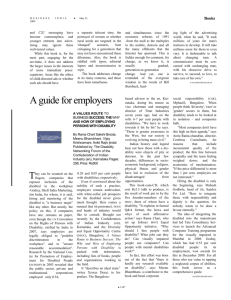

![You can the presentation here [Powerpoint, 1.01MB]](http://s2.studylib.net/store/data/005417570_1-0810139cfc2485ebcaf952e0ae8bb49a-300x300.png)
